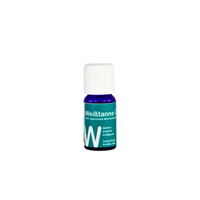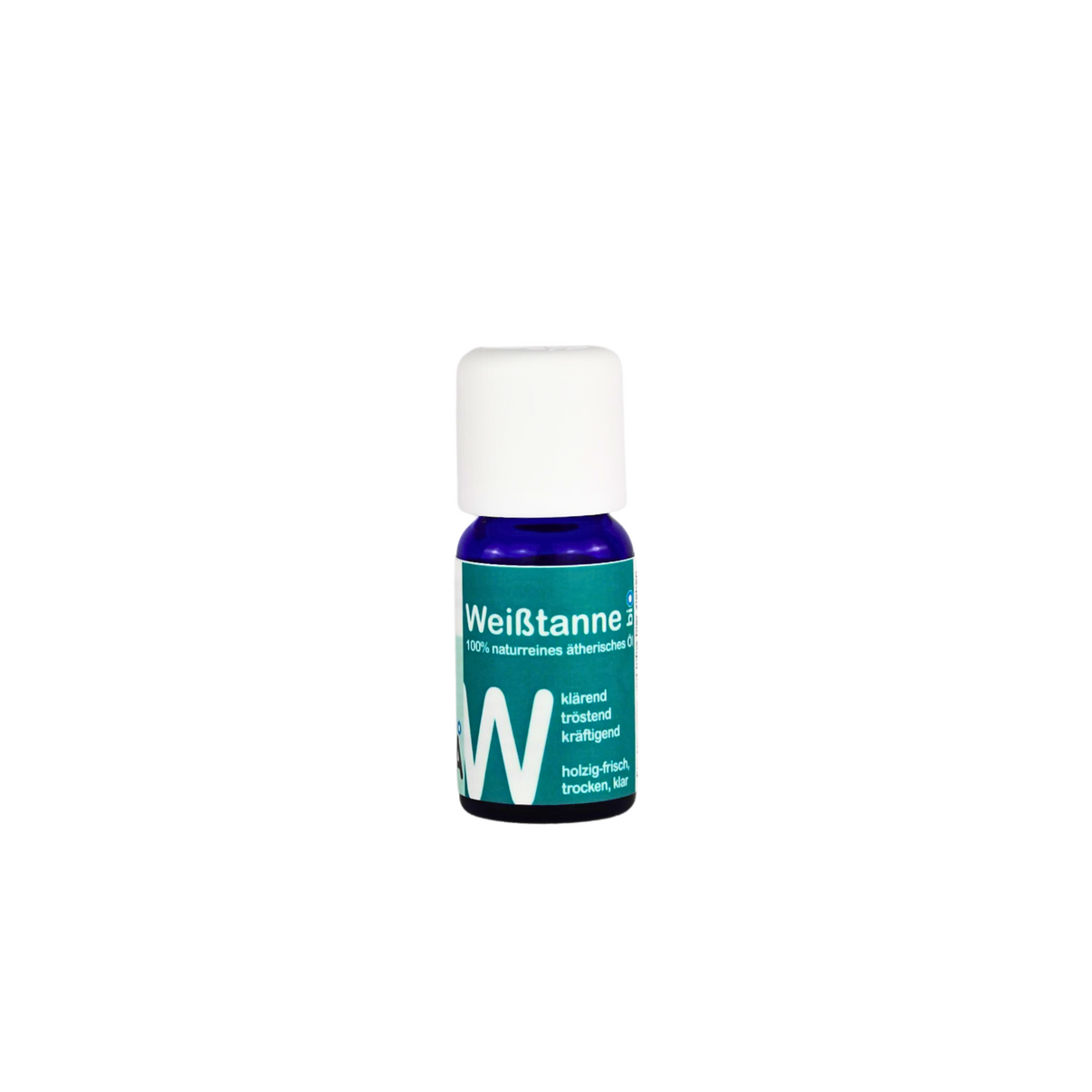Weißtanne bio 10 ml
Your payment information is processed securely.

Weißtanne bio 10 ml
Erhalte eine Benachrichtigung, wenn dieser Artikel wieder auf Lager ist
Produktprofil & Charakteristik
Das ätherische Weißtannen-Öl ist farblos bis gelb und hat eine dünnflüssige Konsistenz. Sein Duft ist holzig-frischen, klar, trockenen bis würzig-waldig. In Verweildauer, Intensität und Wirkung wird es den Kopfnoten zugeordnet.
Das Öl löst sich leicht in Alkohol, Pflanzenölen und anderen ätherischen Ölen. Es ist nahezu unlöslich in Wasser.
Zutaten: Zu den natürlichen Bestandteilen des naturreinen ätherischen Öls zählen
Pinene, Limonene, Camphene, Longifolen u. a.
Inhalt: 10 ml 100% naturreines ätherisches Öl - 1 ml entspricht ca. 25 Tropfen
Deutsche Pharmazentralnummer (PZN): 11305748
Artikelnummer: 11001/315010
Eigenschaften
Das ätherische Öl der Weißtanne ist eine starke Unterstützung für unser Immunsystem. Zudem wird es oft bei Müdigkeit und Energielosigkeit eingesetzt.
Ätherischem Weißtanne-Öl werden in der Fachliteratur folgende Eigenschaften zugeordnet:
- antibakteriell
- schleimlösend
- antiviral
- antiinfektiös
Herstellung
Weißtannen-Öl wird durch Wasserdampfdestillation aus den Zweigen des Kieferngewächses gewonnen.
Hinweise
Beachte die Gefahrenhinweise auf dem Etikett. Das Fläschchen ist mit einem kindersicheren Verschluss und Senkrecht-Tropfer versehen. Zum Dosieren des ätherischen Öls den Kopf des Fläschchens senkrecht nach unten halten, um dann die einzelnen Tropfen abzählen zu können. Nach dem ersten Öffnen kann es je nach Konsistenz des Öls etwas dauern, bis die ersten Tropfen zu sehen sind. Achtung: Ätherische Öle sind Konzentrate, die nur verdünnt angewendet werden dürfen! Einige der Inhaltstoffe von ätherischem Weißtannen-Öl sind auf der Haut angewandt oder durch Einnahme als gesundheitlich bedenklich einzustufen. Es enthält potentiell allergenwirksame Bestandteile, die bei empfindlichen Personen auf der Haut zu Hautreizungen führen können. Es darf bei Bronchialasthma oder Keuchhusten und im Bereich der Augen nicht angewendet werden. Ätherisches Weißtannen-Öl eignet sich nicht für die innere Anwendung bei Schwangeren, Säuglingen und Kleinkindern. Alle Tannennadelöle bilden mit Sauerstoff leicht Peroxide, die sensibilisierende Eigenschaften aufweisen können. Daher muss für therapeutische Anwendungen besonders auf die Frische des ätherischen Öls geachtet werden.
Verpackung & Aufbewahrung
In lichtgeschützten Blauglas-Flaschen mit kindersicherem Verschluss
Das Fläschchen lichtgeschützt bei Temperaturen von 15 bis 22 °C und vor Kindern sicher aufbewahren.
Header Switch (Don't remove)
Generelle Fragen zu Ätherischen Ölen
Was macht unsere Ätherischen Öle Besonders?
- 100 % naturrein: Unsere Öle sind ohne Zusatz von synthetischen Stoffen oder anderen Ölen.
- Bio und nachhaltig: Wir verwenden ausschließlich Konzentrate von Pflanzen aus kontrolliert biologischem Anbau (kbA).
- Genuin & authentisch: Das Öl wird unverändert, naturbelassen und nur aus der angegebenen Stammpflanze laut botanischer Bezeichnung gewonnen.
- Natürliche Wirkung und vielseitig: Es gibt zahlreiche Anwendungsmöglichkeiten und Duftkombinationen zum Selber Mischen. Mit unseren ätherischen Ölen kannst du dich zu Hause, im Büro und unterwegs in gesunder Atmosphäre wohlfühlen
- Gute Qualität zu einem fairen Preis: Da unsere Öle 10 ml pro Fläschchen enthalten, sind wir gegenüber der Konkurrenz, die oftmals nur 5 ml pro Fläschchen anbietet, deutlich günstiger.
Warum sollte man ätherische Öle ausprobieren?
Ätherische Öle sind eine gute und gesunde Alternative zu chemiehaltigen Raumsprays und künstlichen Duftstoffen. Mit ätherischen Ölen kannst du auf gesunde Weise einen angenehmen Duft in deinem Zu Hause, im Büro oder wo auch immer du dich aufhältst, schaffen.
Zudem haben ätherische Öle eine angenehme Wirkung und können dir je nach Note und Duft beim Entspannen oder Konzentrieren helfen, beruhigend oder auch tröstend wirken oder auch erfrischend, belebend und aktivierend sein. Die abwechslungsreichen Düfte und vielfachen Anwendungsmöglichkeiten können dein Wohlbefinden steigern und eine schöne Bereicherung für deinen Alltag sein. Probiere es einfach mal aus und lass dich überzeugen!
Wie können Aromen auf den Körper wirken?
Aromen können über mehrere Wege auf deinen Körper wirken. Naheliegend ist die Erfassung von Aromen über die Nase: Die Riechnerven geben das Signal ins Gehirn weiter und können so Stimmungen beeinflussen.
Eine weitere Wirkungsweise ist über die Haut. Die Moleküle der ätherischen Öle können durch die Zellmembranen und die Haut durchgehen und so in das Gewebe und ins Blut gelangen. Auch über diesen Weg sind sie daher in der Lage eine Wirkung im Körper zu beeinflussen.
Eine dritte Wirkweise ist über den Magen: Wenn wir Gewürze wie z.B. Pfefferminze oder Thymian essen, die ätherische Öle enthalten, gelangen sie in den Magen und entfalten über diesen Weg ihre Wirkung.
Gibt es Risiken und Nebenwirkungen bei ätherischen Ölen? Und was ist dran an der Kritik zu Aroma Therapie?
Ätherische Öle sollten nur verdünnt angewendet werden, denn hohe Konzentrationen können zu Kopfschmerzen und allergischen Reaktionen führen
Da ätherische Öle vielfältige Wirkungen haben (starke Substanzen mit starker Wirkung), sollten sie gut überlegt angewendet werden
Bei der Aromatherapie handelt es sich um eine ganzheitliche Therapieform für Körper und Seele. Es ist schwer die Therapie naturwissenschaftlich zu bewerten. Sinnes- und Gefühlseindrücke, die durch die Öle ausgelöst werden, sind nicht objektivierbar.


